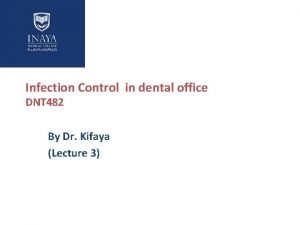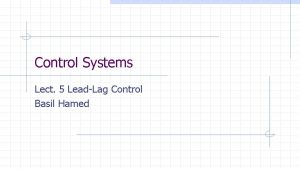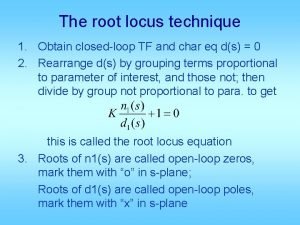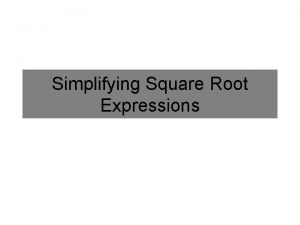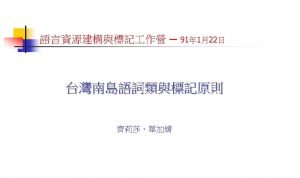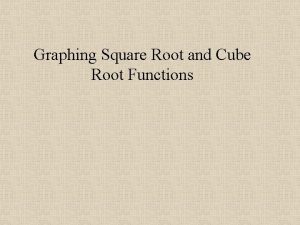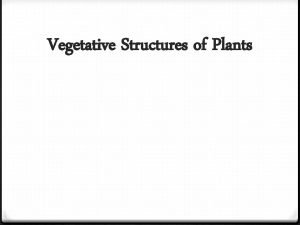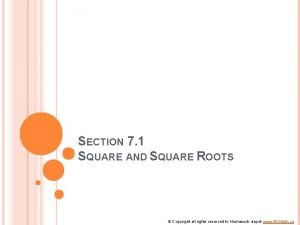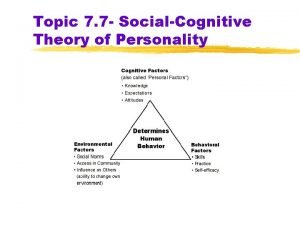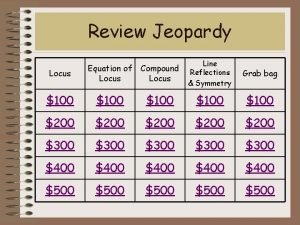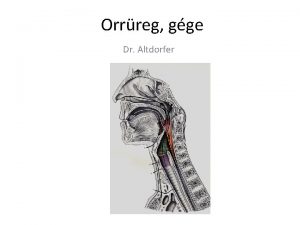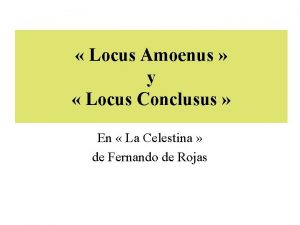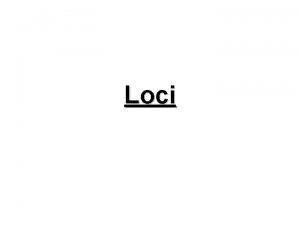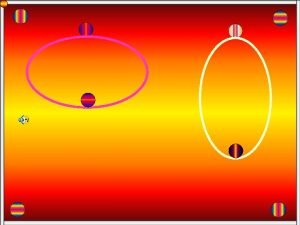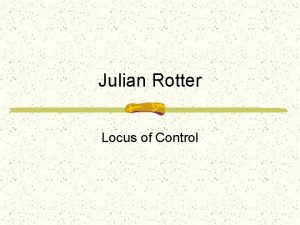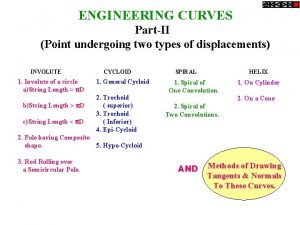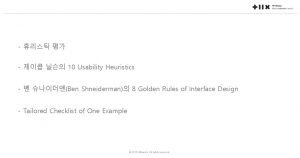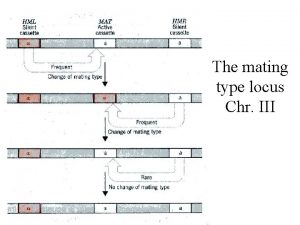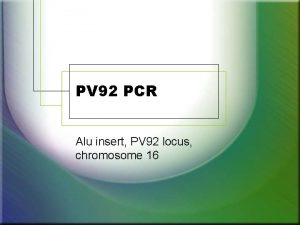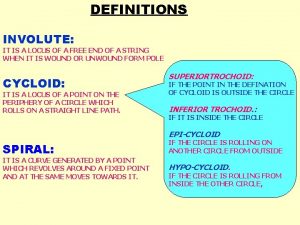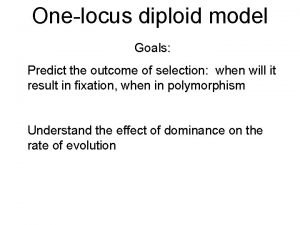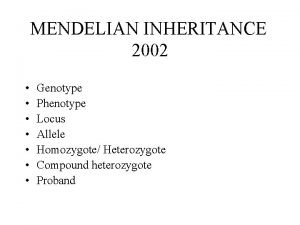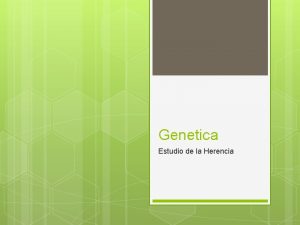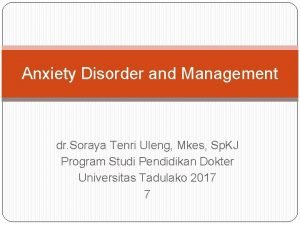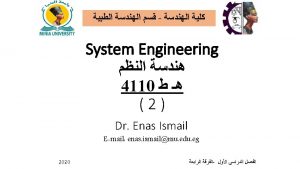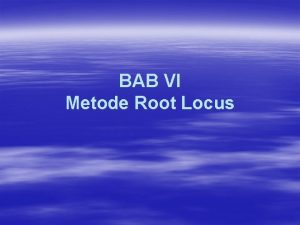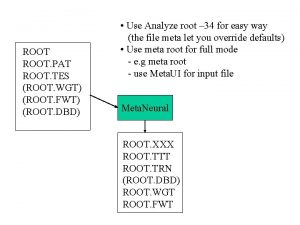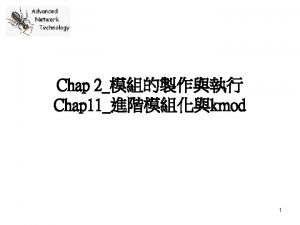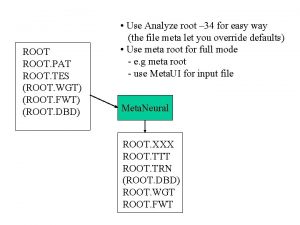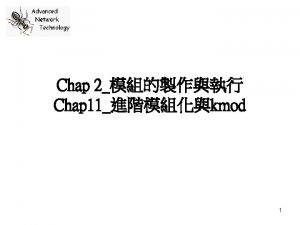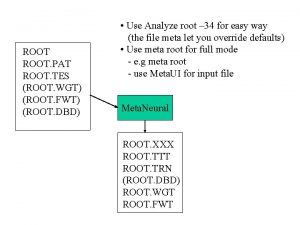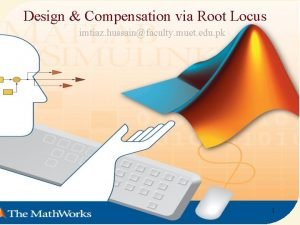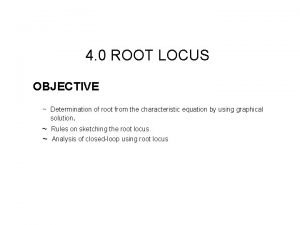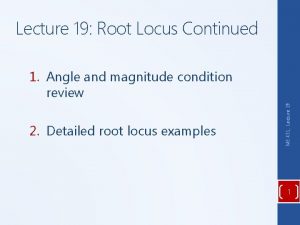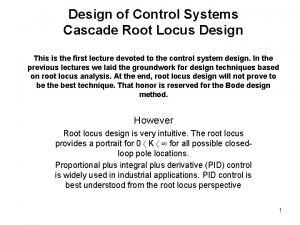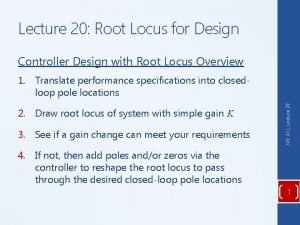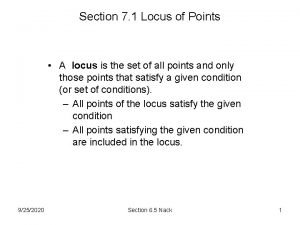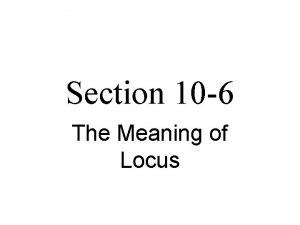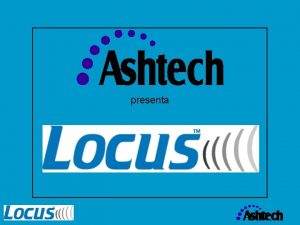CH 9 Design via Root Locus 9 1


























































- Slides: 58

CH. 9 Design via Root Locus

9. 1 Introduction Figure 9. 1 a. possible design point via gain adjustment (A) design point that cannot be met via gain adjustment (B); 需補償器設計

9. 1 Introduction Figure 9. 1 a. possible design point via gain adjustment (A) design point that cannot be met via gain adjustment (B); Figure 9. 1 (b) responses from poles at A and B

補償器種類 Figure 9. 2 Compensation techniques: a. cascade; b. feedback

• 9. 2節: design of cascade compensation to improve ess • 9. 3節: design of cascade compensation to improve 暫態反應 • 9. 4節: design of cascade compensation to improve both ess and 暫態反應 • 9. 5節: design of feedback compensation

9. 2 cascade compensation to improve steady-state error • 改善 ess 補償器 3種 1/S : idea integral compensator 理想積分器 → ess = 0 亦變 transient response Fig. 9. 3 b (i. e. 變根軌跡圖) K 1 + K 2/S : PI controller → ess = 0 可不變 (S+Zc)/(S+Pc) : ( Proportional-plus-Integral) transient response Fig. 9. 3 c Pc <Zc Lag Compensator → ess ↓ 可不變 transient response

Figure 9. 3 a. root locus b. not on the root locus with 1/S compensator added 此設計已無從獲致系統 A

• 補償器 1/S : idea integral compensator → ess = 0 ∵ system type 增 1 ess = finite → ess = 0 (缺點 active network) (缺點 變transient response)

Figure 9. 3 c. on root locus with PI compensator added 當 a 甚小 → 0 不變 transient response PI controller 補償

• (S + a)/S : PI controller → ess = 0 ( Proportional-plus-Integral) ∵ system type 增 1 可不變 transient response 當 a 甚小 Fig. 9. 3 c (缺點 active network) (不變transient response)






Closed-loop system for Example 9. 1: 設計目標: 希望 ess = 0; 不變 transient response Figure 9. 4 (下頁說明控制器選擇) before compensation after PI compensation

• 改善 ess 補償器 3種 (控制器選擇) 1/S : idea integral compensator 理想積分器 → ess = 0 亦變 transient response Fig. 9. 3 b (i. e. 變根軌跡圖) K 1 + K 2/S : PI controller → ess = 0 可不變 (S+Zc)/(S+Pc) : ( Proportional-plus-Integral) transient response Fig. 9. 3 c Pc <Zc Lag Compensator → ess ↓ 可不變 transient response

Example 9. 1 Figure 9. 5 Root locus for uncompensated system of Fig. 9. 4(a) 3階系統 Figure 9. 6 Root locus for compensated system of Figure 9. 4(b)

Figure 9. 7 time response PI compensated system response and the uncompensated system response of Example 9. 1 設計目標: ess = 0 不變 transient response

Figure 9. 8 PI controller


Uncompensated system 先畫根軌跡 找出系統現況 2/11

Uncompensated system 找未補償系統的穩態誤差 3/11 e(∞) = 1/(1 + Kp) = 0. 108 Kp =lims→ 0 G(s) =164. 6/20 = 8. 23

• 改善 ess 補償器 3種 (控制器選擇) 1/S : 4/11 idea integral compensator 理想積分器 → ess = 0 亦變 transient response Fig. 9. 3 b (i. e. 變根軌跡圖) K 1 + K 2/S : PI controller → ess = 0 可不變 (S+Zc)/(S+Pc) : ( Proportional-plus-Integral) transient response Fig. 9. 3 c Pc <Zc Lag Compensator → ess ↓ 可不變 transient response

5/11


Uncompensated system 7/11 e(∞) = 1/(1 + Kp) = 0. 108 Kp = lims→ 0 G(s) = 164. 6/20 = 8. 23 ec(∞) = 0. 0108 由Gc(s) 調整

Figure 9. 12 Compensated system of Figure 9. 11 ec(∞) = 0. 0108 = 1/(1 + Kpc) Kpc = lims→ 0 Gc(s)G(s) = lims→ 0 Gc(s) Kp = lims→ 0 Gc(s) 8. 23 = 91. 593 lims→ 0 Gc(s) = Zc/Pc = 11. 132 Gc(s) = (s+Zc)/(s+Pc) → 取 Pc=0. 01 → Zc=0. 111 8/11

Table 9. 1 9/11 Predicted characteristics of uncompensated and lagcompensated systems for Example 9. 2

Figure 9. 13 Step responses of uncompensated and lag-compensated systems for Example 9. 2 10/11

Figure 9. 14 Step responses of the system for Example 9. 2 lag compensator 更趨近原點 → 反應較慢 最終之ess不變 11/11

執行 Lag compensation 的相關公式

9. 3 Improving Transient Response via Cascade Compensation • 改善 暫態反應 補償器 3種 S : pure differentiator S + Zc : 純微分器 PD controller ( Proportional-plus-Derivative) (S+Zc)/(S+Pc) : Pc > Zc Lead Compensator 超前補償器

Figure 9. 15 Using PD compensation (S + Zc) 改變暫態反應 %OS不變 a. uncompensated; b. compensator zero at – 2; c. compensator zero at – 3; d. compensator zero at – 4 1/3

Figure 9. 16 time response 2/3 Uncompensated system and ideal derivative compensation solutions from Table 9. 2

Table 9. 2 Predicted characteristics for the systems of Figure 9. 15 3/3

Example 9. 3 : S + Zc : PD controller Figure 9. 17 Feedback control system 1/7 設計目標: 補償後系統 %OS = 16% tsc = ts/3 i. e. ζ=0. 504

Figure 9. 18 Example 9. 3 Root locus for uncompensated system 先求未補償系統位置 %OS = 16% →ζ=0. 504 次求未補償系統 ts ts = 4/(ζωn) = 4/1. 205 = 3. 32 2/7

Figure 9. 18 Example 9. 3 Root locus for uncompensated system 2/7

Figure 9. 19 Compensated dominant pole superimposed over the uncompensated root locus for Example 9. 3 3/7 希望補償後 tsc= 3. 32/3 = 1. 107 → (ζωn)c = 3. 613 → %OS 不變 →補償後 dominant poles = -3. 613± j 6. 192 希望補償後 dominant poles = -3. 613± j 6. 192 設計 Gc(s) = S + Zc PD controller →∠Gc(s)G(s) = 1800 目標

Figure 9. 20 4/7 Evaluating the location of the compensating zero for Example 9. 3 希望之角度補償 ∠S + Zc = 1800 -∠G(s)

Figure 9. 21 Root locus for the compensated system of Example 9. 3 5/7

Figure 9. 22 time response Uncompensated and compensated system step responses of Example 9. 3 6/7

Table 9. 3 Uncompensated and compensated system characteristics for Example 9. 3 7/7

Figure 9. 23 PD controller S + Zc

Example 9. 4 Lead compensator design (S+Zc)/(S+Pc) : Pc > Zc 設計目標: 補償後系統 %OS = 30% i. e. ζ=0. 358 tsc = ts/2 Figure 9. 26 uncompensated and compensated dominant poles


Figure 9. 25 Three of the infinite possible lead compensator solutions Lead compensator 貢獻的角度 (S+Zc)/(S+Pc) : Pc > Zc ∠(S+Zc)/(S+Pc) = θc 正值 超前控制器 目標 →∠Gc(s)G(s) = 1800 超前控制器設計 → 選擇 Lead compensator 貢獻的角度 → ∠Gc(s) = ∠(S+Zc)/(S+Pc) = θc

Table 9. 4 Comparison of lead compensation designs for Example 9. 4 Which is the best design? 系統階數? 是否有2個主要極點? 是否有零點? 能否抵消? 比較規格達成度 確認最佳設計

Figure 9. 28 Compensated system root locus (which is this design? )

Figure 9. 29 Uncompensated system and lead compensation responses for Example 9. 4

9. 4 design of cascade compensation to improve both ess and 暫態反應 • improve both 暫態反應 first • then improve ess • Example 9. 5 自修




2. 先調暫態反應 g. Lead 補償器 Gc. L(s)設計 補償後系統 at s = -3. 588± j 7. 003 Gc. L(s) 角度貢獻 ∠Gc. LGH(s) = -1800 ∠Gc. L(s) = -1800 - ∠GH(s) = -1800 – (-164. 650) = - 15. 350 Gc. L(s)= (S+Zc)/(S+Pc) Pc > Zc 選 Zc = 6 → Pc = 29. 1 ∣k Gc. L(s)GH(s)∣= 1 → k = 1977 4/5

3. 後調穩態誤差 essc= ess/10 ess=1/Kv Kv=lims→ 0 sk. GH(s)= 192. 1/60 ess=1/Kv=60/192. 1 h. Lag 補償器 Gc. Lag(s)設計 經 Lead 補償後系統 at s = -3. 588± j 7. 003 Lag 補償器 需維持 system at s = -3. 588 ± j 7. 003 且降 essc= ess/10 = 60/1921 k Gc. Lag(s) Gc. LGH(s) Type 1系統 Gc. Lag(s)= (S+Zc)/(S+Pc) Pc <Zc i. e. Kvc=lims→ 0 s Gc. Lag(s) k. Gc. LGH(s) = 1921/60 lims→ 0 Gc. Lag(s) = (Zc/Pc )(1977/291) = 1921/60

 Design via root locus
Design via root locus Root locus plotter
Root locus plotter The locus rule
The locus rule Root locus break in and break away points
Root locus break in and break away points Root locus departure angle
Root locus departure angle Root locus
Root locus Construction of root loci
Construction of root loci Departure angle root locus
Departure angle root locus Root locus departure angle
Root locus departure angle Root locus definition
Root locus definition![]fd t,k ]fd t,k](data:image/svg+xml,%3Csvg%20xmlns=%22http://www.w3.org/2000/svg%22%20viewBox=%220%200%20200%20200%22%3E%3C/svg%3E) ]fd t,k
]fd t,k Root locus drawer
Root locus drawer Lag lead compensator in control system
Lag lead compensator in control system Root-locus techniques
Root-locus techniques Root-locus techniques
Root-locus techniques Arteria epigastrica superficialis
Arteria epigastrica superficialis Decimoquinta estacion via crucis
Decimoquinta estacion via crucis Via positiva and via negativa
Via positiva and via negativa Vialucis que es
Vialucis que es Segunda motoneurona de la via corticonuclear
Segunda motoneurona de la via corticonuclear Palavras convergentes
Palavras convergentes What is an irrational number
What is an irrational number Pine leaves
Pine leaves Bound root
Bound root Graphing square and cube root functions
Graphing square and cube root functions Part of flower
Part of flower Dmca square root
Dmca square root Rami ventralis
Rami ventralis Ventral root
Ventral root Tpicos
Tpicos Cognitive theory personality
Cognitive theory personality Focalización interna ejemplos
Focalización interna ejemplos Locus of corruption
Locus of corruption Compound locus
Compound locus Os nasale
Os nasale Locus amoenus en la celestina
Locus amoenus en la celestina Loci worksheet
Loci worksheet Locus is
Locus is What is locus of a point in mathematics
What is locus of a point in mathematics The locus rule
The locus rule Locus of points inside triangle
Locus of points inside triangle Root rotter
Root rotter Engineering curves
Engineering curves Locus horrendus romantismo
Locus horrendus romantismo Locus kiesselbachi
Locus kiesselbachi Locus coerulius
Locus coerulius Usability heuristics checklist
Usability heuristics checklist Mat locus
Mat locus Pv92 locus
Pv92 locus Locus plural
Locus plural Locus
Locus Involute of a circle
Involute of a circle A gene locus is
A gene locus is One locus
One locus Locus
Locus Wage schooling locus
Wage schooling locus Leyes de la genetica
Leyes de la genetica Locus
Locus Tenri management
Tenri management
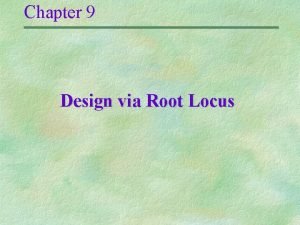
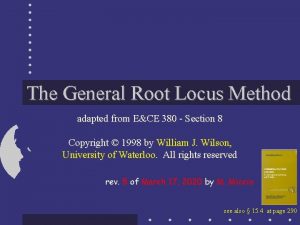
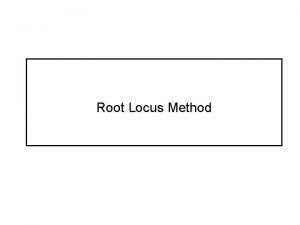
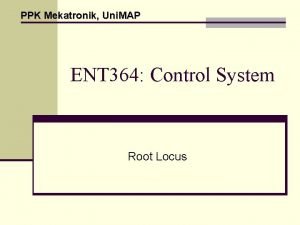
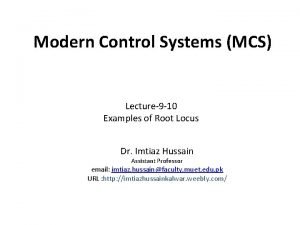
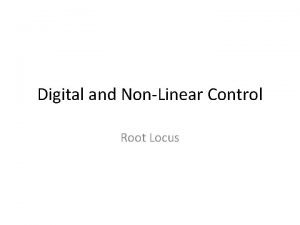
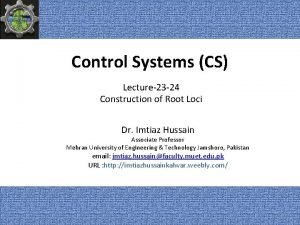
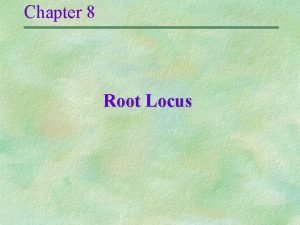
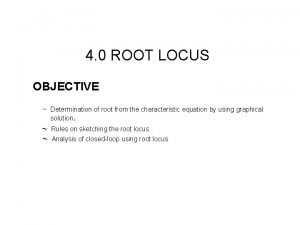
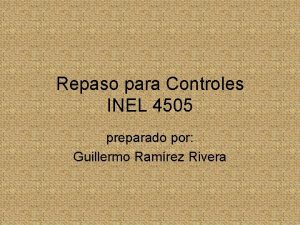
![]fd t,k ]fd t,k](https://slidetodoc.com/wp-content/uploads/2021/03/5339945_336d0641f8787e276535de75bd7da2e9-300x225.jpg)
